Author : Barry Thompson
When Riviera unveiled its revamped 51 EFB Series II at SIBS it marked the discontinuance of the exceptionally popular 51 Series 1, of which nearly 170 had been sold in the four years of its existence, but more importantly the birth of a sensational new flybridge design and the new IPS propulsion option.
While you may be excused for not at first noticing much of a change from the outside, because there virtually isn’t any, it’s inside that most of the improvements and alterations have been done. Most obvious is the flybridge that has had a facelift and is now reminiscent of the Riviera 61. There are also a lot more flat timber surfaces, especially in the galley area and the rear bulkhead has been transformed with double opening stainless doors and huge awning window.
There are also a number of other subtle changes internally to make what was already a great boat even better. The change was a natural evolution and after feedback from current 51 and 47 flybridge owners, Riviera took note of their comments and made alterations where they were felt to be justified.
But unquestionably the biggest transformation is the powertrain. Following extensive testing in the United States, the Riviera 51 is now available with triple Volvo Penta IPS drive systems. While conventional shaft drives are still offered, the triple Volvo Penta IPS600 is certainly a favoured option. And after testing hull #1 I can see what the attraction is. The boat is nimble and agile for such a big beast and most of all it returns great fuel figures. However, while the IPS installation will certainly prove a popular package I am sure that there will still be those buyers out there who are traditionalists when it comes to what powers their boat. Options are Caterpillar 715hp and MTU 825hp Series 60 engines and both engine packages are only a knot or two slower than the triple IPS 600 installation. With the Volvo Penta IPS, the 51 has a cruising range of 425 nautical miles at a speed of 31 knots. Maximum speed for the boat at a half load condition of 23.3 tonnes is 34 knots. However, in bad weather a cruise speed of 20 knots will give an extended range of 460 nautical miles.
According to Riviera, at 25 knots the IPS boat returns around 150L/h and with the shaft drive option fuel consumption is closer to 175L/h for the same speed.
Interestingly the extra cost for the high horsepower MTUs or triple Volvo Penta IPS600s, instead of the standard Caterpillar power package, is the same at $A75,000
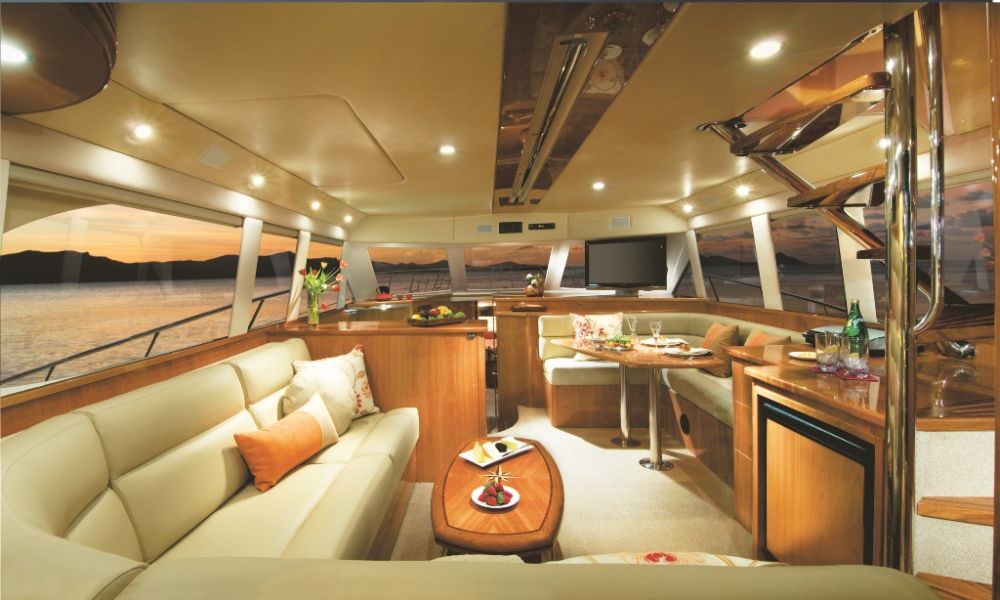
The IPS powered option features a modified hull, developed by Riviera’s design team in consultation with Volvo Penta senior designers. However, the changes made to the hull were reasonably small considering the huge change from shafts to pods. These have been done using mould inserts and can be simply removed when a customer orders a conventional shaft drive version. From aft of the central bulkhead the keel was removed and tunnels were fitted to enable all the drivelines to be at the right height. The 15 degree deadrise at the transom and the chines remained the same.
With the hull having to be totally rebalanced, the 3700-litre fuel tank has been repositioned over 2m forward, immediately behind the accommodation bulkhead. This has the bonus of not only being central enough so the fuel burn doesn’t affect the balance of the boat, but it also reduces engine noise in the accommodation area. Displacement has dropped by a few hundred kg.
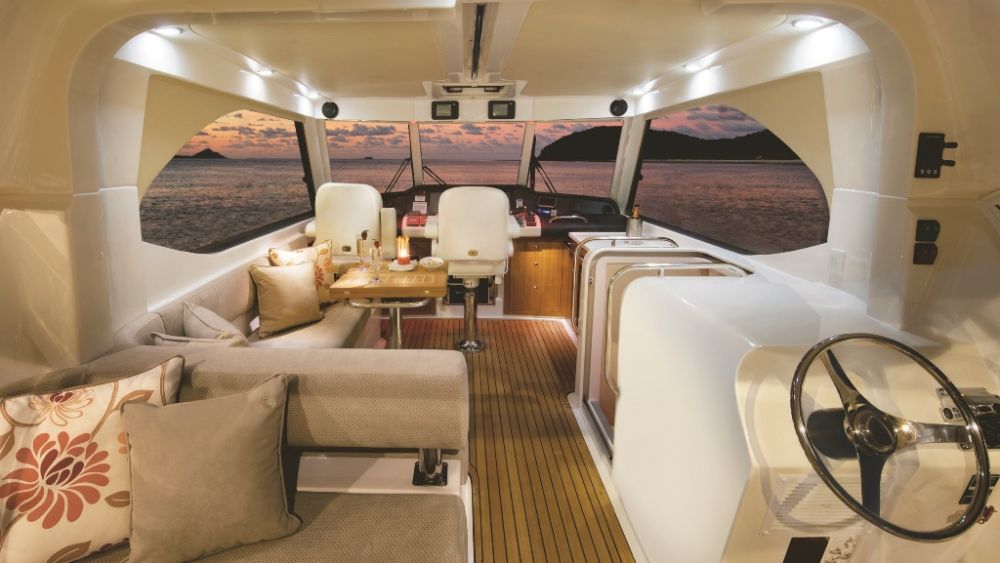
Three-Cabin Layout
The Riviera 51 EFB offers a three-cabin, two-head layout with a forward VIP cabin, port side guest and owners’ stateroom to starboard. The VIP cabin has a 2m-long queen size bed surrounded either side with lockers, shelves and drawer space. All the lockers are cedar lined. The bed base lifts on gas struts to reveal another huge storage area and there is also a set of drawers accessed from the front of the base.
Like all the cabins there is the added comfort of reverse cycle air conditioning, plus the deck hatches are fitted with blinds to control the light and keep out the bugs.
Your guests will share an en-suite with two-door access, with entry from either the forward cabin or off the companionway. This is another area in the 51 Series II that has come in for an upgrade, with a new timber locker, a solid surface vanity counter, above-bench basin, Amtico timber veneer flooring and even a new chrome shower pole.
The port side cabin has twin single bunks with storage lockers above and below and like the other cabins offers a high level of comfort.
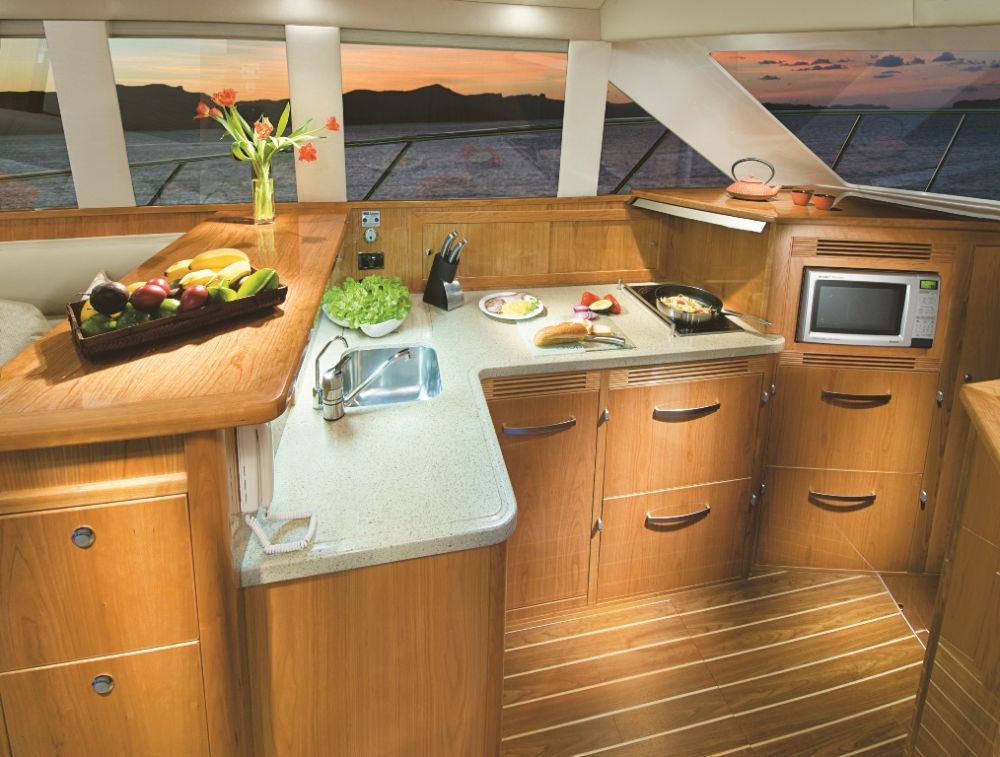
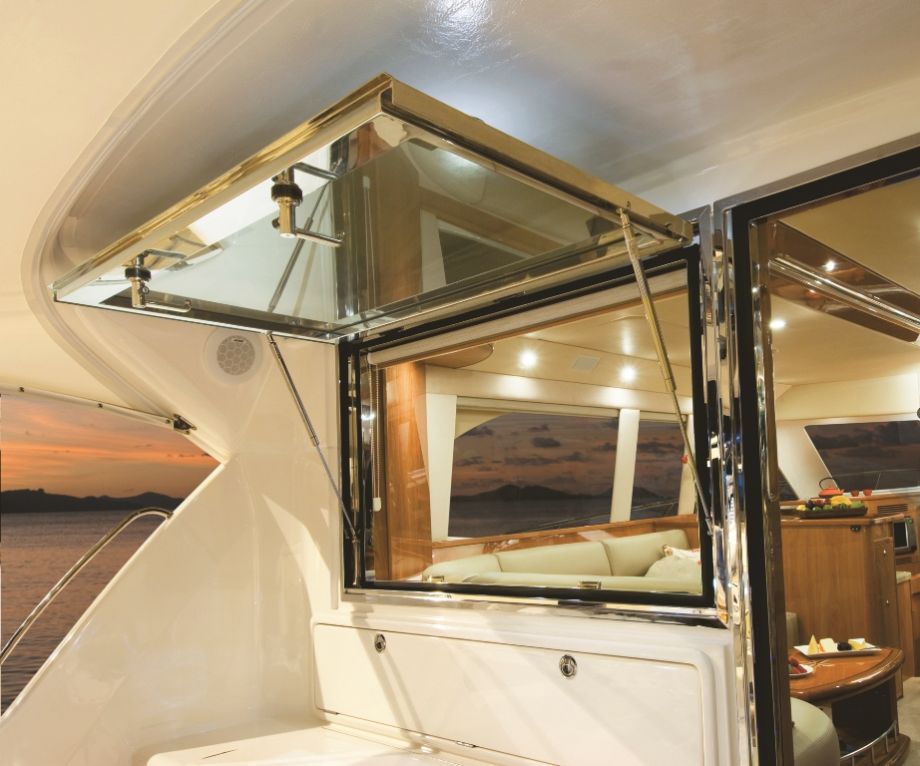
The master stateroom is spacious, rich in timberwork and in the new Series II features an even bigger island berth that allows good access either side. Like the queen size berth in the VIP stateroom, the base is on gas struts for ease of access to another massive storage area. Riviera has certainly made great use of all the available space for storage in all areas of the cabin.
The overall scheme of the fabrics is light and fresh and provides a warm appealing ambience that is reflected right throughout the vessel.
Hidden away discreetly behind louvered doors in the companionway is the laundry with a combination Meile washer/dryer and drying racks.
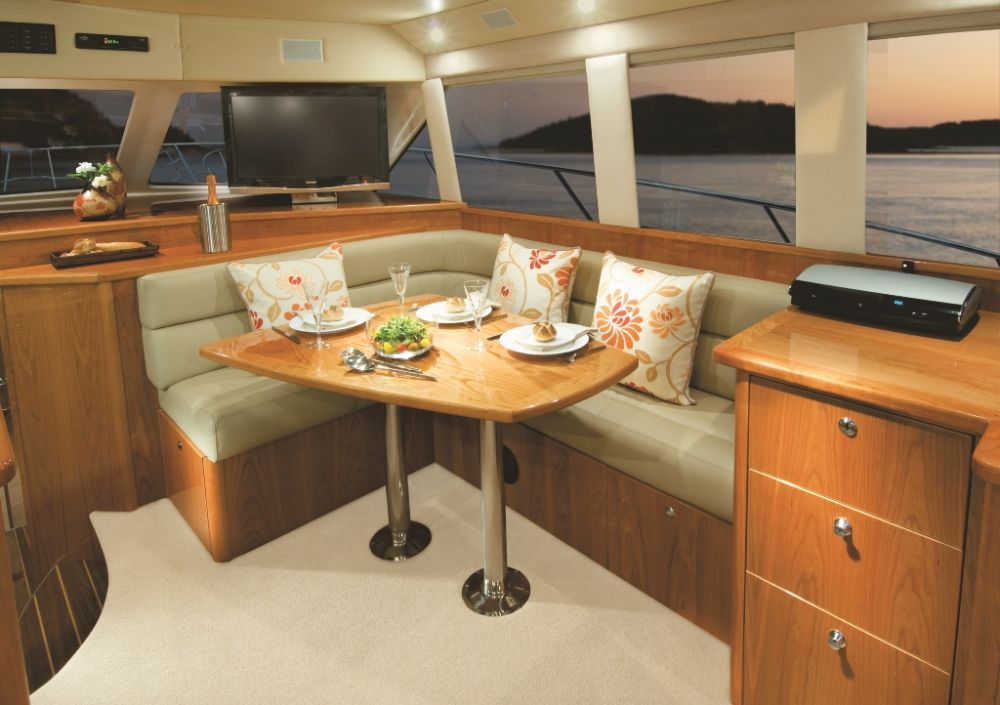
Redesigned & Stylish
A few steps up from the accommodation areas, the galley, while being at a slightly lower level than the saloon, is high enough so anyone working there is still very much in touch with those enjoying the entertainment behind.
The big difference here is the combination drawer fridge/freezer that is faced with the same cherry panelling as the rest of the galley and saloon area. There are the usual amenities such as convection microwave, two-burner ceramic hob, dish drawer, generous storage and pantry space. Amtico was chosen for the sole due to its durability and hardwearing properties, so necessary in such a high traffic area. The solid surface bench top has a top access rubbish bin as well as a large stainless steel single sink.
A major difference between the 51 Open and the 51 Enclosed flybridge models is how you get above. In the Open version you have a ladder from the cockpit and in the Enclosed version an internal staircase. This has not changed in the Series II, with the same spiralled staircase with open treads above the bench top level that help maintain the open concept of the saloon.
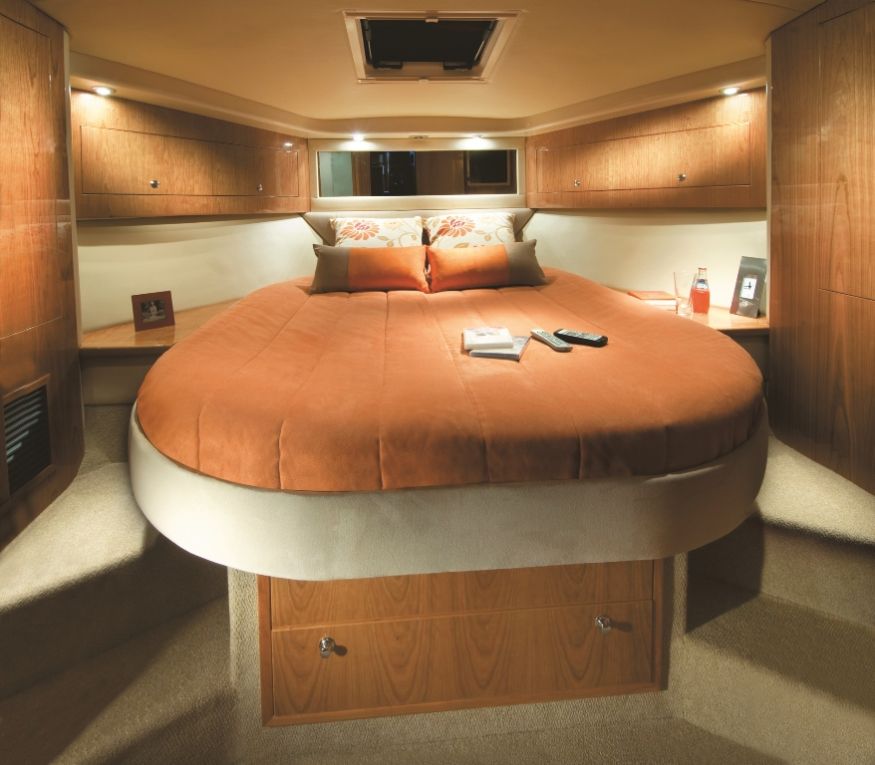
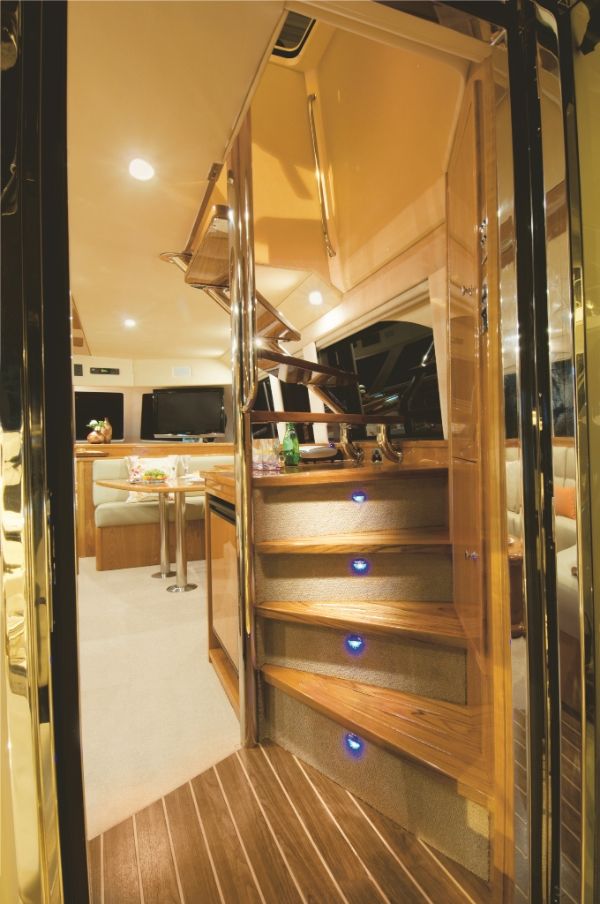
One of the particularly neat features of the 51 is the L-shaped lounger that conceals an electrically operated foldout double bed. When in daytime use there is a large coffee table or an optional ottoman. Above is a rod storage locker hidden away in the headliner for your expensive fishing tackle and running the full length of the cabin a recessed grab rail is flanked with timber panelling which provides a hard relief in the soft cream cabin panelling. Opposite and forward across from the galley is the second lounger and main dining area with a full-size fixed table. Add a couple of loose chairs and you have comfortable dining for at least six.
Below the staircase Riviera has built in a drinks locker with dedicated areas for bottles and glasses as well as a fridge/icemaker combo. Speakers for the Bose entertainment system are recessed in stylish pelmets on either side of the saloon.
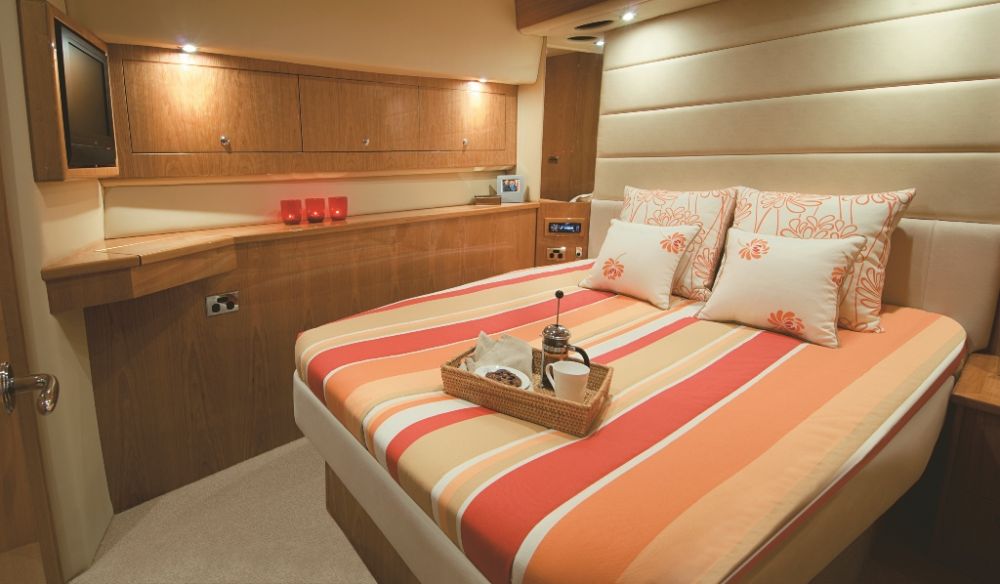
Because of the IPS installation, the area under the saloon, traditionally the domain of the engines, is now a large storage area. An option offers crew’s quarters including bunk and a fully equipped bathroom. Access to the space is via a door from the cockpit. There is also an option to provide a second access via a hatch in the saloon. The space includes the boat’s genset, air conditioning units and battery banks, offering very easy servicing. It is also used to access the front of the three Volvo Penta IPS engines.
The Riviera 51 EFB I reviewed was finished in a high gloss cherry but you do have the option of teak or beech in either a satin or gloss finish.
Another obvious change is the new stainless steel awning window that really brings the saloon and cockpit area together seamlessly. Previously the solid bulkhead had a sliding window, although the tackle storage locker, eutectic freezer and access to under the saloon have been retained. However, what was the engine room access is now the entry to the huge storage space left by having the IPS engine package under the cockpit sole. The Open model retains the sliding bulkhead window and a ladder from cockpit to flybridge.
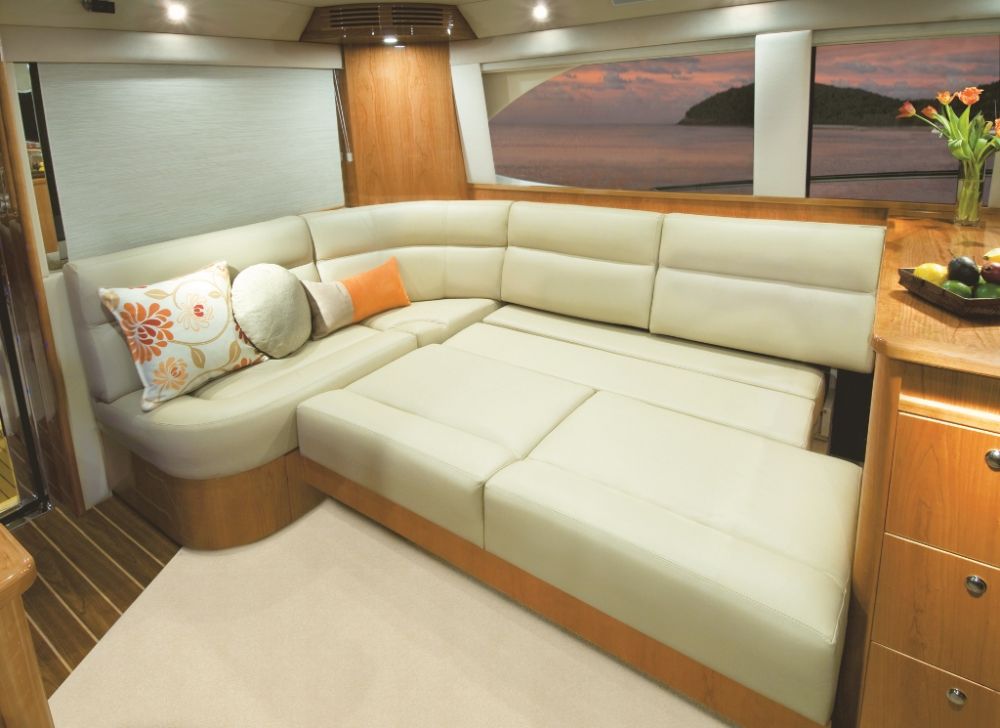
The cockpit is designed as a working area for the serious fisherman, with such features as recessed cleats and a set of engine controls, but it also doubles as a nice open space for general cruising activities. There are storage lockers under the wide side coamings and a live bait tank in the transom, plus a large central kill tank and IPS pod drive access hatches in the teak cockpit sole. The main access to the engines is via the hinged cockpit floor that lifts on an electric actuator.
A full width moulded boarding platform has a fold-away extendable ladder on the port side.
Dinghy storage on the Riviera 51 is on the foredeck, with a Davco deck crane looking after retrieval and launching of the RIB.
Much Improved Flybridge
The enclosed flybridge has an all-new layout. It has a new wrap-around helm with an upholstered dark grey vinyl helm peak while the lower section is finished in a soft touch dark grey paint and features directional air-conditioning outlets for the windscreen and two free standing Pompanette Golden helm chairs.
The helm’s design provides ample room for electronics including the IPS joystick as well as a glove box and drink holders. Below the helm is a bank of drawers and locker doors giving access into the forepeak of the flybridge. On the starboard side there is additional storage cabinetry finished in high gloss timber while on the port side there is a large inner-sprung lounge with a storage drawer for glassware under the aft seat.
Riviera concept design manager, Neil McCabe, said they set out to create a more social seating arrangement around the helm.
“With the long luxurious lounge starting next to the captain’s helm seat and flowing aft around the centrally positioned folding gloss timber table, there is a real feeling of space and comfort while the captain remains firmly connected to the gathering even under way. At rest the two helm seats can rotate around, the table folded open and the party continues,” he said.
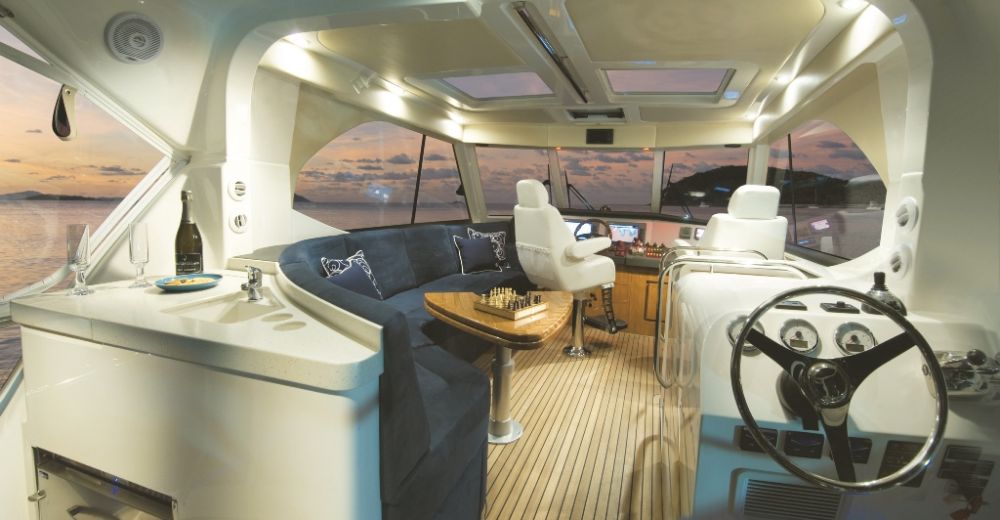
The enclosed flybridge has an all-new layout. It has a new wrap-around helm with an upholstered dark grey vinyl helm peak while the lower section is finished in a soft touch dark grey paint and features directional air-conditioning outlets for the windscreen and two free standing Pompanette Golden helm chairs.
The helm’s design provides ample room for electronics including the IPS joystick as well as a glove box and drink holders. Below the helm is a bank of drawers and locker doors giving access into the forepeak of the flybridge. On the starboard side there is additional storage cabinetry finished in high gloss timber while on the port side there is a large inner-sprung lounge with a storage drawer for glassware under the aft seat.
Riviera concept design manager, Neil McCabe, said they set out to create a more social seating arrangement around the helm.
“With the long luxurious lounge starting next to the captain’s helm seat and flowing aft around the centrally positioned folding gloss timber table, there is a real feeling of space and comfort while the captain remains firmly connected to the gathering even under way. At rest the two helm seats can rotate around, the table folded open and the party continues,” he said.

TECHNICAL SPECIFICATIONS
- Design Name: Riviera 51 Series II
- Builder: Riviera Group
- Year Launched: 2009
- LOA: 17.73m
- LWL: 16.67m
- Beam : 4.93m
- Draft: 1.38m
- Displacement: 21,800kg
- Max Speed : 33 knots
- Cruise Speed: 28 knots
- Fuel Capacity: 3700 litres
- Water Cap: 860 litres
- Construction: GRP
- Engines: Volvo Penta IPS600




